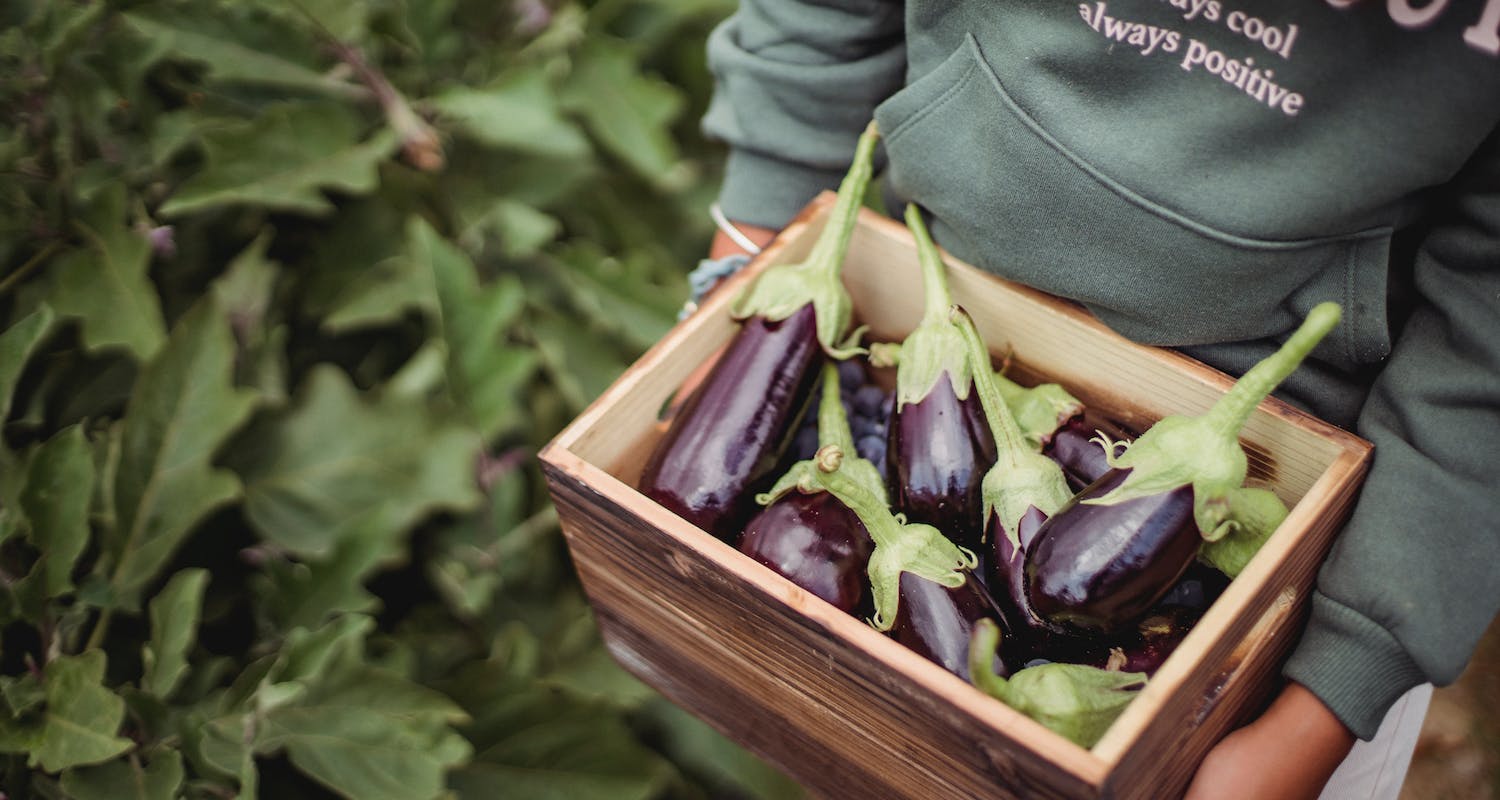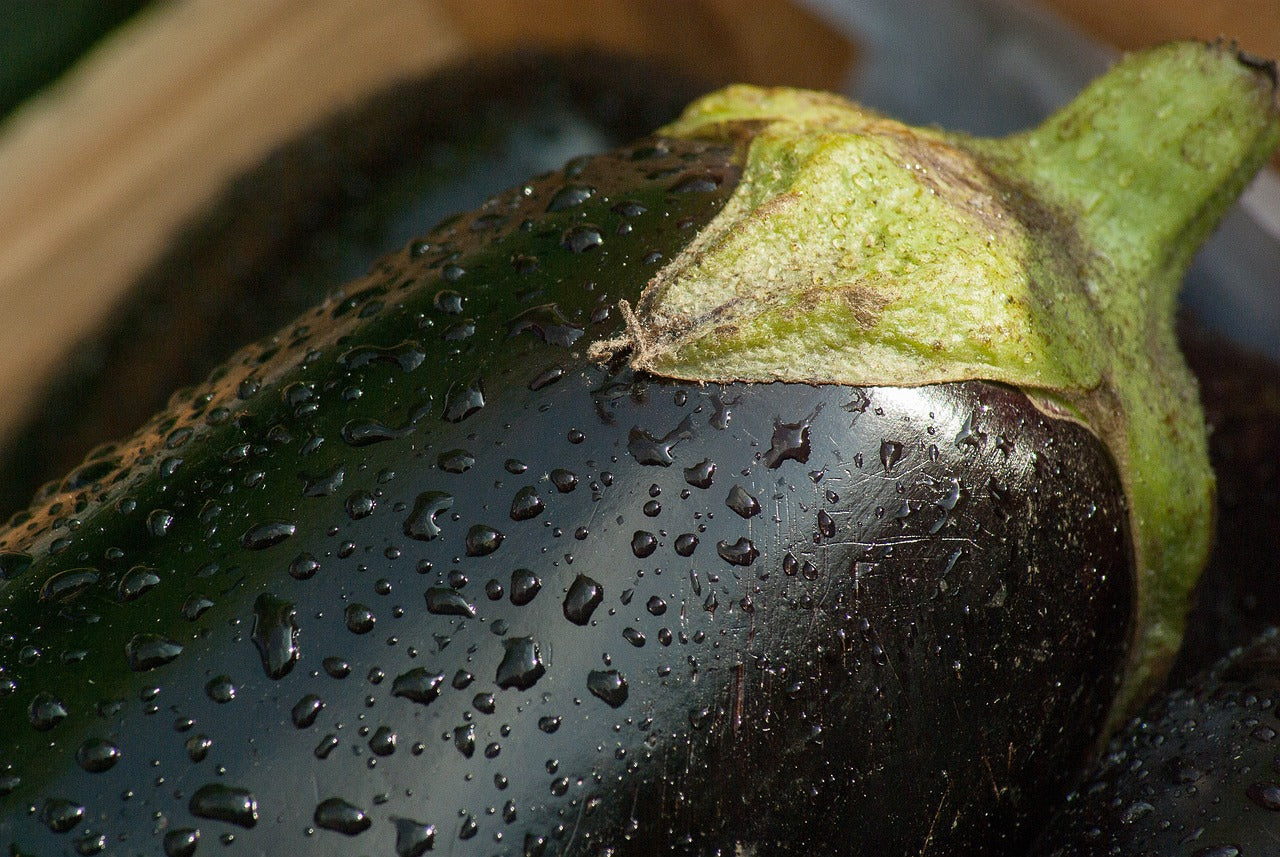Growing Aubergines: UK Beginner’s Guide

Aubergines are a wonderfully versatile and tasty vegetable, featuring heavily in both Mediterranean and Asian cuisines and in favourite dishes such as brinjal bhaji, aubergine parmigiana, moussaka and ratatouille. Although not the easiest vegetable to grow, they are definitely worth making the effort in order to get fresher, tastier aubergines on your plate - especially if you’ve got the means to grow them under cover. Here are some pointers from our growers to help you get it right.
Jump to:
- Growing from seed
- Which aubergines are easiest to grow?
- Grafted aubergines
- Growing from plants
- Plant care
- Harvesting and storing
- Problem solving
How to grow aubergines from seed
Aubergines need a long growing period, so they’re amongst the first seeds you should sow. Start in February, using a heated propagator or seedling heat mat, or keep them in a warm room. Sow plenty, as it’s likely that they won’t all germinate or survive the seedling stage. Once your seedlings have grown a pair of true leaves (the first pair don’t count), carefully transplant them into individual pots and keep them in a warm, well-lit place.
Which aubergine plants are easiest to grow?
Since aubergines are slow growing and need lots of warmth and sun to produce fruits, the smaller fruited varieties are often better for UK gardens. It can also be more rewarding to grow types that you don’t usually find in the shops, such as the pink, white or striped varieties.

What’s a grafted aubergine?
Grafting is where the plant breeder joins together two different vegetable plants which have certain qualities (such as disease resistance or vigorous growth) to produce a plant with the best features of both.This can really benefit more tender vegetables such as aubergines.
Grafted plants tend to have better root systems, which means the plants can take up more water and nutrients from the soil, growing bigger and producing more fruit. Many of them also seem to crop for a longer period of time.
If you live in a colder area or don’t have heated growing equipment, you might want to consider using grafted plants - they’ll stand up to more cold than non-grafted plants, saving you money and disappointment.
How to grow aubergines from plants
Growing from plants is much easier, especially if you’ve left it a bit late or you need to replace failed seedlings (shakes fist at the sky). You can buy them in spring and grow them on in pots or plant them straight outside in a greenhouse or polytunnel if the last frost date has passed. This varies according to where you live, and can be checked here. Plant them in soil with lots of good compost or manure mixed in, and make sure you have robust pest protection in place.
Can you grow aubergines outside?
Not without some kind of coverage usually - you’ll need to grow them in a greenhouse, conservatory or polytunnel in your garden, or on a windowsill indoors, as they need a consistent temperature above 20°C to produce full sized fruits. It may be possible to grow outdoors in long, hot summers or in very mild areas, but I wouldn’t risk it in Yorkshire. If you do fancy your chances, wait until the middle of June when it’s consistently warm, and protect your plants on colder nights by covering them with horticultural fleece or cloches.
Growing aubergines in pots
Aubergines are a good plant to grow in pots as you can control their temperature and light requirements more easily. Use pots at least 30cm wide and deep, filled with multi purpose compost, and plant one aubergine per pot. You can also use grow bags, planting 2-3 aubergines per bag.

Aubergine plant care
How much sun do aubergines need?
Aubergines are a tender crop that need a lot of sunlight and warmth to grow and produce fruit.
Position them where they’ll get 6-8 hours of direct sunlight every day, with daytime temperatures of around 20°C.
The best soil for aubergine plants
Aubergines need fertile, well-draining soil. If yours is a bit on the dry or clay-heavy side, mix in plenty of garden compost into your garden soil until it becomes crumbly and rich - three parts compost to one part garden top soil is a good mix to aim for. Aubergines are hungry plants, so they’ll benefit from an initial feed added to the soil. If you’re really well prepared you can add a layer of manure to your soil the autumn before, and let it break down. This will add extra nutrients to the soil as well as improve its texture.
How much space do aubergine plants need?
Aubergines planted in the ground need to be spaced 60cm apart to allow for the plants to spread, and for air and sunlight to reach every part of them. If you’re growing your aubergines in pots, use one pot per plant and avoid crowding them together.
How much water do aubergines need?
Aubergines need consistently moist soil, so be careful not to let them dry out (it makes the fruits taste bitter if you do). Check and water them regularly, especially those in pots - in the height of summer you can expect to be doing this daily. If you can, water them in the morning and avoid splashing the leaves, to prevent moulds and mildews developing. You should also mist the leaves regularly (once or twice a day, especially if they’re growing under cover) to deter red spider mites (see below) and encourage fruiting.

Do you have to feed aubergine plants?
Aubergines need regular feeding if they’re to produce fruits. As soon as your plant starts flowering, feed it every week with a potassium rich fertiliser such as liquid tomato feed, which encourages the fruits to form. Aubergines grown outside will also benefit from a mulch to provide them with extra nutrients, retain water in the soil and keep the weeds down around them.
Do aubergine plants need support?
As aubergine fruits can grow very large and heavy, the plants need to be supported to stop them breaking under the weight. A strong garden cane or bamboo stick is ideal - position it 2-3cm away from the stem and tie it in carefully with a soft plant tie, twine or pipecleaners every 20cm or so. Alternatively, you can grow the plant next to a trellis or horizontal wire supports, and tie it to that. If you get a heavy crop, you might need to add more canes as the plant grows.
How to pollinate aubergine plants
If, like most of us, you’re growing your aubergines under cover, it can be difficult for pollinating insects to get access. Make sure you open the door or vents of your greenhouse or cold frame regularly to help them. You can also help by misting and hand pollinating your plants - use a paintbrush and transfer pollen from one flower to another by gently brushing inside the middle of each flower on the plant.
How to harvest aubergines
Your aubergines will be ready to harvest from late July through to the beginning of October if the weather stays warm. When they’ve reached full size (or the size you want them), are a good colour and have glossy skin, cut through the stalk with a clean, sharp knife to harvest them. Hold the aubergine in one hand as you cut, to steady the plant and avoid damaging it. If any new flowers or fruits start to form after around late August, there’s little chance of them growing to maturity so you should remove them, to let the plant put its energy into the others.
Storing aubergines
Aubergines need careful handling as they can bruise or dry out easily. They can be kept in a cool place in the kitchen or in the fridge for up to a week (ideally no colder than 8°C or you can find they develop dark squishy bits).
You can freeze aubergines, if you slice and blanch them first, or freeze ready cooked slices. Alternatively, you can preserve them as aubergine pesto or brinjal pickle.
By the way, if you have an old recipe book which tells you to salt aubergines before cooking in order to remove the bitterness, you can ignore that. Aubergine varieties now are far less bitter than they used to be, so this is no longer necessary.

Aubergine plant problems
Flea beetles
Like the rest of the Nightshade family, aubergines can fall prey to the disconcertingly named flea beetles. These little black bugs swarm over the leaves, eating tiny holes which damage the plant and can cause stunted growth. To prevent flea beetles attacking your plants, you can cover them in a horticultural fleece. When the plant blooms, however, you’ll need to remove this to allow pollinating insects access. Flea beetles are inherently lazy and don’t like to travel far from the ground, so you could also try positioning your aubergine pots on a table or bench or in a raised planter.
Red spider mites
Red spider mites are tiny (about 1mm) red beasties that are often a problem in greenhouses.
If left unchecked they can cover entire leaves in their webs while sucking the sap from them, causing yellowing leaves, leaf drop and sometimes the death of the plant.
To prevent the red menace infesting your aubergine plant, mist the leaves daily - they don’t like that. You can also use biological control against red spider mites, by introducing predator mites such as Phytoseiulus persimilis. These can be bought online and are a natural way to control pests.
Aphids
Ugh, these guys again. Aphids are small green bugs that cluster on the plant stems, particularly at the joints, and also the underside of leaves. They cause leaves and fruit to become discoloured and misshapen. Aphids also leave behind a sticky residue known as honeydew which can then promote the growth of a fungus known as sooty mould. Delightful.
Like whiteflies, ladybirds and hoverflies enjoy eating aphids so planting marigolds nearby will help control them. You can also use soapy water to blast the aphids off the plant.
Whitefly
Whiteflies look like small white moths and are most commonly found on the underside of leaves. If left to their own malign devices they will feed on the leaves, damaging them and turning them yellow. Your best defence against whitefly is to simply spray your plant down with some water or a mix of water, vegetable oil and soap, aiming it at the whiteflies to try and wash them off. Make sure you check the whole plant and get as many of the fiends off as possible.
You can also plant companion plants such as marigolds near your cucumbers. Marigolds deter whitefly as well as attracting ladybirds and hoverflies which will come and feast on the pests.
Last updated: 05/03/2024




















